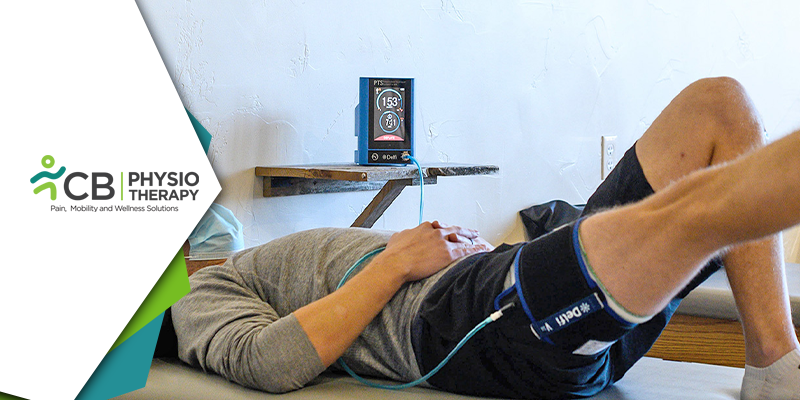Certain people suffer from muscle weakness or stiffness due to conditions like Chronic pain, Post-operative weakness, Post-trauma muscle atrophy, etc. Such people require high load resistance training for improving muscular strength and obtaining muscle hypertrophy. Also, individuals with conditions like COPD, diabetes, cancer, HIV, etc require muscle strength training but cannot tolerate loaded exercises or high-intensity exercises. For such patients, the Blood Flow Restriction (BFR) training technique is found to be beneficial. This training technique combines low-intensity exercise with blood flow occlusion that produces similar results to high-intensity training. It has been used by well-trained and qualified physiotherapists in clinical settings. And the pressure is custom-designed for the patient, making the BFR training safer and more effective. In this blog, we will discuss BFRT and its benefits.
Blood flow restriction (BFR) training is a kind of exercise training, in which the physiotherapist places the specialized tourniquet cuff near the targeted muscles, around the limb to decrease the blood flow, and then begins low-intensity exercises. BFR training entails using the FDA-approved medical tourniquet device as an individual goes through low to moderate training. There is a restriction of the flow of venous blood while the arterial blood still supplies to the limbs, thus helps increasing metabolic stress and cellular swelling. The tourniquet is wrapped around the limbs, either around the arms directly under the shoulder or around the legs just below the hip. The cuff limits the blood outflow, and the blood with low oxygen collects increasing lactic acid and protons. This causes a release of hormones, cell swelling, and hypoxia during low-intensity exercise, as experienced during a high-intensity workout.
Blood flow restriction training (BFRT) can be combined with different forms of exercises like passive, resisted aerobic exercises. Blood flow restriction training has lots of promising benefits, explained below.
Increase strength and muscle size:
The BFR training increases strength and muscle size, due to the synthesis of protein that occurs during this form of training. This training induces favorable changes in muscle mass and strength with a considerably low training load. The protein synthesis from this training is combined with reduced muscle damage to build lean muscle. As the damage from BFRT is minimal, therefore makes it an effective form of training over traditional strength training.
Gain more strength:
BFR training can be done by anyone regardless of fitness level. It helps to increase muscle size, strength, and endurance in healthy people.
Regain strength after injury:
BFR training can also be done to improve strength and muscle size while recovering from an injury. The recommended intensity for muscle growth to occur is strength training at 60-80% of 1 repetition maximum (1RM), which is almost impossible after an injury, and for that, the blood flow restriction training, which requires 20-30% of 1RM, is recommended.
Gain more while doing less:
More strength is gained by BFR training compared to the traditional strength training exercises because it requires only 20-30% of 1RM to produce results and can also be done by using lighter weights. Individuals who can't lift heavy weights for too long can do this kind of training for maximum results.
Works with most exercise:
There is no specific form of exercise attached to the BFR training, thus it can be easily incorporated into any form of exercise. A usual exercise routine can be followed to reduce the weight or intensity, with a BFR band or specialized tourniquet, and get to work.
Anti-aging effects:
Regular exercise is an effective way to reduce the risk of certain illnesses that come with old age. BFRT helps stimulate the production of growth hormone, which helps grow lean muscle. A tourniquet is tied to the limb, it affects the blood circulation and the growth hormone is released in the bloodstream and impacts every area of the body that is being exercised. This increases collagen production, thus slowing down the effects of aging on the skin.
Helps in recovery:
BFR training helps in recovery, especially from a tough workout or injury to any part of the body. Despite the high level of muscle fatigue during BFR exercise, the effect of BFR on muscle fatigue is diminished after 2 min of reperfusion. BFRT has a strong but short-lasting effect on neuromuscular function, it also helps in the process of recovery.
Short sessions:
BFR sessions last up to 7-20 minutes and are found to be effective on the muscles. A great workout within a short period and can get quality results with blood flow restriction training. It requires lighter weights, which helps to do more within a short time frame.
Improves muscle endurance:
BFR training is an alternate method to improve muscle endurance. During this form of training, there is a limited flow of oxygen to the muscles, which makes the slow-twitch Type I muscle fibers less active than normal. As a result of this, the Type II, anaerobic muscle fibers are activated. This usually happens with high-intensity training but restricted blood flow helps to build muscle endurance.
Prevents muscle soreness:
Low load BFRT causes positive collagen turnover, which helps in healing and recovery. Also, there is a lesser risk of muscle damage or delayed onset muscle soreness (DOMS).
BFRT is found to be effective in increasing muscle size, strength, and endurance capacity, even with low intensities and resistances. It provides additive training effects that augment skeletal muscle and cardiovascular adaptations. It works for individuals of all ages and abilities and should be done under the supervision of a well-qualified physiotherapist with a blood flow restriction certification. In case of any medical condition, an individual should see a physician to be sure that the individual is cleared for this kind of training.

